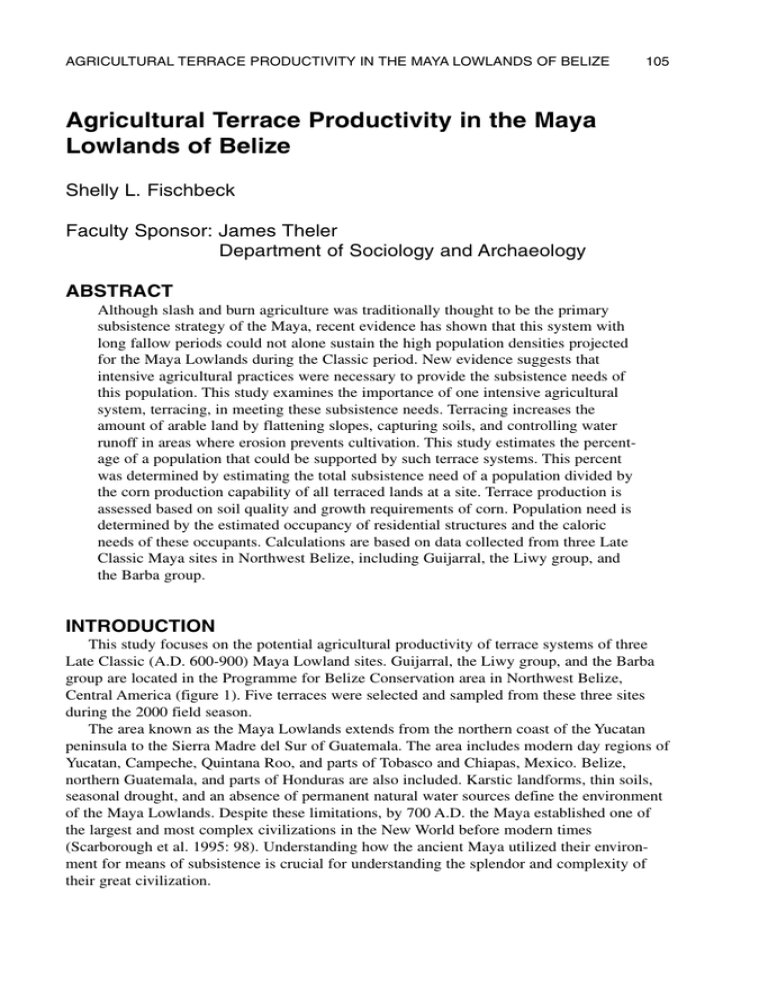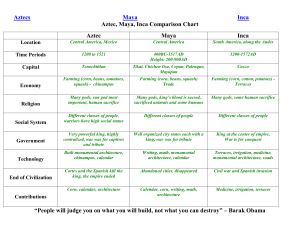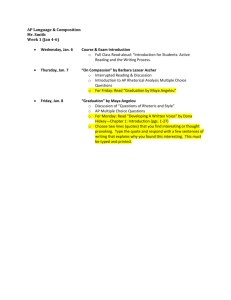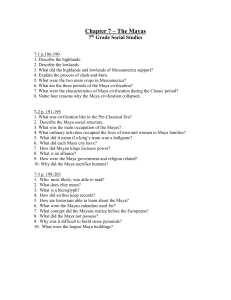Agricultural Terrace Productivity in the Maya Lowlands of Belize Shelly L. Fischbeck
advertisement

AGRICULTURAL TERRACE PRODUCTIVITY IN THE MAYA LOWLANDS OF BELIZE 105 Agricultural Terrace Productivity in the Maya Lowlands of Belize Shelly L. Fischbeck Faculty Sponsor: James Theler Department of Sociology and Archaeology ABSTRACT Although slash and burn agriculture was traditionally thought to be the primary subsistence strategy of the Maya, recent evidence has shown that this system with long fallow periods could not alone sustain the high population densities projected for the Maya Lowlands during the Classic period. New evidence suggests that intensive agricultural practices were necessary to provide the subsistence needs of this population. This study examines the importance of one intensive agricultural system, terracing, in meeting these subsistence needs. Terracing increases the amount of arable land by flattening slopes, capturing soils, and controlling water runoff in areas where erosion prevents cultivation. This study estimates the percentage of a population that could be supported by such terrace systems. This percent was determined by estimating the total subsistence need of a population divided by the corn production capability of all terraced lands at a site. Terrace production is assessed based on soil quality and growth requirements of corn. Population need is determined by the estimated occupancy of residential structures and the caloric needs of these occupants. Calculations are based on data collected from three Late Classic Maya sites in Northwest Belize, including Guijarral, the Liwy group, and the Barba group. INTRODUCTION This study focuses on the potential agricultural productivity of terrace systems of three Late Classic (A.D. 600-900) Maya Lowland sites. Guijarral, the Liwy group, and the Barba group are located in the Programme for Belize Conservation area in Northwest Belize, Central America (figure 1). Five terraces were selected and sampled from these three sites during the 2000 field season. The area known as the Maya Lowlands extends from the northern coast of the Yucatan peninsula to the Sierra Madre del Sur of Guatemala. The area includes modern day regions of Yucatan, Campeche, Quintana Roo, and parts of Tobasco and Chiapas, Mexico. Belize, northern Guatemala, and parts of Honduras are also included. Karstic landforms, thin soils, seasonal drought, and an absence of permanent natural water sources define the environment of the Maya Lowlands. Despite these limitations, by 700 A.D. the Maya established one of the largest and most complex civilizations in the New World before modern times (Scarborough et al. 1995: 98). Understanding how the ancient Maya utilized their environment for means of subsistence is crucial for understanding the splendor and complexity of their great civilization. 106 FISCHBECK The Lowlands consist primarily of upland tropical rainforests, interrupted by patches of savanna and seasonal swamplands called bajos (Voorhies 1982: 65). These three physiographic zones vary in drainage, slope, soil and vegetation (Turner 1987: 164). Much of the area lacks perennial fresh surface water, the most notable exceptions being the Ucumacinta river drainage in the west, the Three Rivers region in the east, and the central Peten Lakes region. Monsoon-type rains inundate the area from May through December and provide the majority of fresh water. Annual rainfall averages between 1000 and 3000 millimeters and varies regionally, with the higher percentages falling in the south (Culbert et al. 1987: 159-61). Seasonal drought often occurs between January and April (Scarborough et al. 1995: 98). Soil quality also varies regionally Figure 1. Map of the Programme for Belize Archaeological Project Area (Sanders 1977: 288; Culbert et al. 1987: 160). Sanders (1977: 295) notes the high potential of the soils in the Southern lowlands for intensive agriculture, however, soil quality is usually poor in humid tropic regions. Slope variation, ranging from rolling hills to steep escarpments, combined with deforestation and heavy rain makes erosion a major problem in the lowlands. Despite limitation set by soils, water, and slope, the Maya area was able to sustain large populations. Mayanists have long debated the question of whether high population densities created a need for intensive agricultural practices or if the development of such practices allowed for increased population densities. Some scholars suggest agricultural intensification measures were taken to sustain a rapid population growth of 25 persons per square kilometer in the Middle Preclassic to 210 person per square kilometer in the Late Classic (Willey 1987: 331). Others suggest intensive cultivation seems to preclude these settlement densities (Willey 1987: 331). Nevertheless, it is obvious that intensive agricultural practices would have been needed to sustain these large populations. Cultivation techniques are noted to intensify and expand as the needs of a population increase. The term intensification refers to the frequency in which a particular plot of land is cultivated, while expansion refers to the increase in land area used for cultivation (Hammond 1987: 24-25). Agricultural methods identified in the Maya lowlands include milpa, swidden, terracing, raised field agriculture, and arboriculture (cultivation of tree crops) (Hammond 1987: 24-26). Milpa literally means cornfield, but is often used synonymously with swidden or slash-andburn cultivation (Turner 1987: 22). The swidden cycle begins in late spring when a section of the forest is cut and the fallen vegetation is burned. Once the field is reduced to ash the farmer, or milpero, sows the seeds and waits for the rain. The crop is then harvested before AGRICULTURAL TERRACE PRODUCTIVITY IN THE MAYA LOWLANDS OF BELIZE 107 the dry season begins. In some areas multicropping, the repetition of this cycle multiple times per year, is practiced depending on soil fertility and rainfall (Hammond 1987: 29). The length of time a particular field can be utilized also depends on soil fertility. A plot of land is generally used continuously for one to four years followed by a fallow period of four to seven years. However, the milpa system can be intensified using crop rotation and intercropping to reduce fallow periods (Wiseman 1987: 84). Beans and squash were also cultivated using the milpa system (Hather and Hammond 1994: 330). Root crops such as sweet potato, jicama, manioc, and malango were also likely involved in crop rotation and further contributed to the subsistence base (Hather and Hammond 1994: 330). It should be noted that swidden practices are not solely used for maize production, nor is swidden limited to the large, open fields associated with the milpa. Nevertheless, milpa cultivation was once thought to be the primary means by which the Maya subsisted. However, researchers have shown that this practice alone would not have adequately provided the nutrients or quantities needed for survival (Turner 1987: 13). Therefore, other intensive systems and expanded areas were likely utilized. Terracing is one way of expanding into areas previously unsuited for cultivation. Terraces were constructed along rivers and other drainage systems and slopes. Stone walls, often of some bulk, were used to construct the terraces (Hammond 1987: 26). The stone walls acted as soil retainers to combat erosion during the rainy season. Perpendicular stone alignments crosscutting the terraces, as evident at La Milpa, suggest water was intentionally diverted down the terraces, perhaps as a further means to prevent erosion or to supply water to the fields during the dry season. METHODS Sampled terraces were identified from maps of the sites completed by John Hageman and Paul Hughbanks from Southern Illinois University at Carbondale (figure 2 and 3). Sampled terraces were selected based on their proximity to other excavation being conducted at the sites. Terrace productivity was assessed based on soil analysis from one liter soil samples collected from the profiles of 1x1 meter excavation units. Excavation units were placed approximately one meter behind stone alignment identified as terrace retaining walls. This placement was intended to expose soils captured directly behind the terrace walls to minimize disturbances in the soil profile from erosion. Two samples were collected from each profile at 25 cm below the ground surface and from directly above a cobble fill layer present in each terrace. The 25 cm depth was selected as a control to provide a comparative measure between the terraces and to eliminate possible biased analysis from the nutrient rich decomposing plant matter at the surface. Samples collected from just above the cobble layer were selected because they most closely resemble the soils that would have been present at the time the terraces were cultivated by the ancient Maya. Cobbles are thought to have been intentionally placed in the terrace profile between the arable soil and the clayey weathered limestone bedrock to enhance drainage of the terraced soil (Healy et al. 1983: 405). Terrace productivity was assessed based on soil requirements for corn growth (Wolf 1999; Klingebiel and Montgomery 1961). Factors considered in this assessment include root zone depth, susceptibility to erosion (slope), workability, drainage, soil moisture, and fertility. Fertility includes soil pH, organic matter, cation exchange capacity, phosphorus, potassium, magnesium, sulfur, and nitrogen. Root zone depth, susceptibility to erosion, workability, 108 FISCHBECK drainage, and soil moisture were noted during excavation. Susceptibility to erosion (slope) was measured from the front of the terrace wall to the rear of the planting surface using a handheld clinometer. All soil fertility analyses were conducted by the staff of the Soil and Plant Analysis Lab at the University of Wisconsin-Madison. Total mineral analysis was conducted by Inductively-Coupled Plasma Emission Spectrophotometry (Schulte et al. 1987: 31). Soil pH was measured in a 1:1.3 soil: water ratio using an electrometric pH meter (Schulte et al. 1987: 41). Percent organic matter was determined by loss of weight on ignition. Cation exchange capacity was determined by computer from exchangeable calcium and magnesium (Schulte et al. 1987: 14). Calculations of terrace area, corn yields, population estimates, and caloric requirements will be limited to the site of Guijarral, as mapping of the Barba group and the Liwy group are not completed at this time. Terrace area is determined using a digital planimeter (SigmaScan) to calculate the total area of agricultural terraces mapped at the site. Although not all terraces were confirmed to be agricultural, any terrace that appeared not Figure 2. Map of Guijarral to be a retaining wall to support a structure platform was considered for this study. Terrace productivity was determined by multiplying total terrace area by the potential corn yield. Growth requirements listed are for modern corn (Zea mays L.), but are assumed to be the same for ancient strains for the purpose of this study. However, yields Figure 3. Map of Barba Group AGRICULTURAL TERRACE PRODUCTIVITY IN THE MAYA LOWLANDS OF BELIZE 109 of ancient strains would have been significantly lower than those of modern corn because cob length has increased over time by genetic selection (Kirkby 1973: 126). Yields were calculated based on an average cob length of 9 cm from A.D. 1 to A.D. 1000 (Kirkby 1973: 126). Corn of this size would yield approximately 1.3 metric tons of dried seed per hectare under optimal growing conditions (Kirkby 1973: 60). Population estimates for the Maya Lowlands in the Late Classic period are as high as 200 persons per square kilometer (Rice and Culbert 1990). Population estimates were calculated by counting the total number of structures at a site and estimating an average occupancy of five persons per structure (Flannery 1976: 106). The population estimate was then reduced by –34% to adjust for hidden occupation, non-Late Classic structures, non-residential structures, and structures not in use (Hageman 1997: 4). Studies of modern households in the Valley of Oaxaca estimate that a family of two adults and three children consume one metric ton of corn per year (Flannery 1976: 106). One metric ton would provide approximately 1300 calories per person per day (Kirkby 1973: 127), or up to 65% of the daily caloric requirements of an average adult. To determine the percentage of subsistence needs that could be met by terraced agriculture at the sites in this study, potential corn yields were multiplied by the total area of terraced land at a site. The average amount of corn consumed by the population at the site was then divided by the total corn yield of terraced lands to determine the percent. RESULTS All soil factors analyzed meet or exceed the minimum requirements for corn growth (figure 4). The depth of root zone is slightly shallower than the recommended depth in clay, but forming small mounds of soil for planting, a common practice, could have alleviated this. Terracing greatly decreases erosion hazards by flattening slopes. All terraces sampled had slopes of <5%. Adequate drainage was made possible by the placement of a stone cobble layer between the arable soil and bedrock. Terrace wall construction would also allow downslope movement of water in heavy rains. Planting at the beginning of the rainy season would provide adequate soil moisture throughout the growing season. Workability of the heavy clay soils would have been difficult under hand cultivation; nevertheless, they are adequate for corn growth. Soil fertility exceeds corn growth requirements in all categories. The high organic matter content contributes much of the nutrient density. Studies have shown that land upslope of terraces was often not deforested (Coultas et al. 1993). Downslope movement of decaying plant matter would have maintained adequate organic matter content although the terraces themselves were likely devoid of natural vegetation. Soils with high cation exchange capacities have the ability to hold large quantities of cations (positively charged ions), which act as a reserve of nutrients (Wolf 1999: 177). High cation exchange capacities also allow soils to maintain nutrient densities over long periods (Wolf 1999: 177). Guijarral terrace area was calculated to be 196, 747.0 square meters or 19. 7 hectares. This area multiplied by a potential corn yield of 1.3 metric tons per hectare would yield approximately 25.6 metric tons of corn per planting. A conservative estimate of 66% occupancy of residential structures at Guijarral yielded a population density of approximately 124 people per square kilometer, with an average occupancy of five persons per structure. Total population at the site is estimated to be approximately 700 people, or 140 families of five. The estimated 140 families at Guijarral would consume approximately 140 metric tons of 110 FISCHBECK corn per year. Terraced land at Guijarral has the potential to yield of 25.6 metric tons of corn per planting. Thus, one planting yielding 25.6 metric tons of corn would provide approximately 18.3 % of Guijarral’s annual corn consumption requirement. CONCLUSIONS The potential corn yield of the terrace could meet an estimated 18.3% of Guijarral’s annual corn consumption requirement. This number is very significant considering that terraces comprise only a small percentage of total arable land at Guijarral (approximately 3.5%). Furthermore, it is likely that multicropping, the practice of planting and harvesting a plot of land multiple times per year, was practiced on the terraces. If this was the case, terraced agriculture could provide more than 34% of the total corn required in one year. Furthermore, the practice of intercropping, planting multiple crops on one plot of land, likely increased the total food production of the terraces. Unfortunately, preservation of botanical remain in the Lowlands is very poor. Therefore, it is difficult to determine exactly what was grown on the terraces. Long fallow periods could greatly reduce the annual corn yield of the terraces. In the modern milpa system a plot of land is generally used continuously for one to four years followed by a fallow period of four to seven years. However, fallowing practices on the terraces are not well understood. The high cation exchange capacity of the terraces suggests that they would have been able to maintain adequate nutrient densities over long periods. The results of this study are only estimates of the potential agricultural productivity of ancient Maya terraces. Further research is needed to gain a better understanding of terracing practices. Phytolith analysis of terrace soils may be useful to determine what was grown on the terraces. Experimental planting of the terraces would also be useful to further assess their potential productivity. Furthermore, the sites sampled in this study represent only a small region of the Maya Lowlands. Regional studies are needed to account for regional diversity seen throughout the Lowlands. In conclusion, terracing permits the cultivation of land normally not suited for agriculture. Without this and other intensive agricultural practices, this area could not have sustained the high population densities estimated for the Maya Lowlands during the Late Classic period. AGRICULTURAL TERRACE PRODUCTIVITY IN THE MAYA LOWLANDS OF BELIZE 111 ACKNOWLEDGEMENTS This study was made possible thanks to a University of Wisconsin-La Crosse Undergraduate research grant. Thank you to Dr. James Theler and Dr. Dean Wilder for all your help and comments along the way. Thank you Dr. Kathryn Reese-Taylor, Dr. Fred Valdez, and Jon Hageman for giving me the opportunity that made this study possible. Thank you to all PfBAP students and staff, especially Balta, David, Ubi, Alfonzo, and Michelle for your help completing the field work for this project. Finally, thank you to all my friends and family for their continued support and encouragement. REFERENCES Coultas, C. L., M. E. Colllins, and A. F. Chase. 1993. The Effect of Mayan Agriculture on Terraced Soils of Caracol, Belize. In Proceedings of the First International PedoArchaeology Conference, edited by J.E. Foss, M.E. Timpson, and M.E. Morris. Special Publication No. 93-4. Agricultural Experiment Station, University of Tennessee, Knoxville. Culbert, T. P., P.C. Magers, and M. L. Spencer. 1987. Regional Variability in Maya Lowland Agriculture. In Pre-Hispanic Maya Agriculture, edited by P.D. Harrison and B. L. Turner, pp. 157-161.University of New Mexico Press, Albuquerque. Flannery, K.V. 1976. Empirical Determination of Site Catchments in Oaxaca and Tehucan. In Flannery (Ed.) The Early Mesoamerican Village, pp. 103-117. Academic Press, San Diego. Hageman, J.B. 1997. Late Classic Populations in Northwestern Belize. Paper presented at the 62nd Annual Meeting of the Society for American Archaeology. Nashville, Tennessee. Hather, J.G. and N. Hammond. 1994. Ancient Maya Subsistence Diversity: Root and Tuber Remains from Cuello, Belize. Latin American Antiquity 68: 330-35. Hammond, N. 1987. The Myth of the Milpa: Agricultural Expansion in the Maya Lowlands. In Pre-Hispanic Maya Agriculture, edited by P.D. Harrison and B. L. Turner, pp. 23-34. University of New Mexico Press, Albuquerque. Healy, P.F., J.D.H. Lambert, J.T. Arnason, and R.J. Hebda. 1983. Caracol, Belize: Evidence of Ancient Maya Agricultural Terraces. Journal of Field Archaeology 10: 397-410. Kirkby, A.V.T. 1973. The Use of Land and Water Resources in the Past and Present Valley of Oaxaca, Mexico. Memoirs No. 5. Museum of Anthropology, University of Michigan, Ann Arbor. Klingebiel, A.A. and P.H. Montgomery. 1961. Land Capability Classification. Agricultural Handbook No. 210. United States Department of Agriculture, Washington, D.C. Rice, D.S., and T.P Culbert. 1990. Historical Contexts for Population Reconstruction in the Maya Lowlands. In Precolumbian Population History in the Maya Lowlands, edited by T.P, Culbert and D.S. Rice, pp. 1-36. University of New Mexico Press, Albuquerque. Sanders, W. T. 1977. Environmental Heterogeneity and the Evolution of Lowland Maya Civilization. In The Origins of Maya Civilization, edited by R.E.W. Adams. University of New Mexico Press, Albuquerque. Scarborough, V. L., M.E. Becher, J.L. Baker, G. Harris, and F. Valdez. 1995. Water and Land at the Ancient Maya Community of La Milpa. Latin American Antiquity 6: 98-119. Schulte, E. E., J. B. Peters, and P. R. Hodgson. 1987. Wisconsin Procedures for Soil Testing, Plant Analysis and Feed and Forage Analysis. University of Wisconsin-Extension, Madison. 112 FISCHBECK Turner, B.L. 1987. The Development and Demise of the Swidden Thesis of Maya Agriculture. In Pre-Hispanic Maya Agriculture, edited by P.D. Harrison and B. L. Turner, pp. 13-22. University of New Mexico Press, Albuquerque. Voorhies, B. 1982. An Ecological Model of the Early Maya of the Central Lowlands. In Maya Subsistence: Studies in Memory of Dennis E. Puleston, edited by K.V. Flannery, pp. 65-95. Academic Press, New York. Willey, G.R. 1987. Pre-Hispanic Maya Agriculture: A Contemporary Summation. In PreHispanic Maya Agriculture, edited by P.D. Harrison and B. L. Turner, pp. 325-336. University of New Mexico Press, Albuquerque. Wiseman, F.M. 1987. Agricultural and Historical Ecology of the Maya Lowlands. In PreHispanic Maya Agriculture, edited by P.D. Harrison and B. L. Turner, pp. 63-115. University of New Mexico Press, Albuquerque. Wolf, B. 1999. The Fertile Triangle: The Interrelationship of Air, Water, and Nutrients in Maximizing Soil Productivity. Food Products Press, New York.







